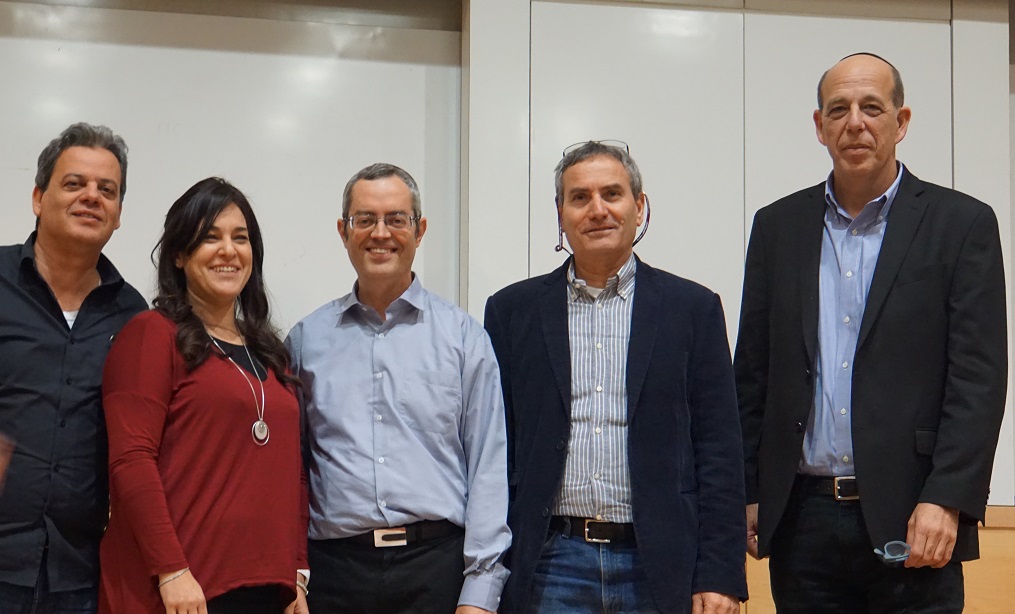Influential Nano Role

In December 2017 Prof. Dror Fixler of the Faculty of Engineering began his tenure as Director of the Bar-Ilan Institute for Nanotechnology and Advanced Materials. In his inaugural speech, Prof. Fixler presented his elaborate vision of the Institute.
In December 2017, Bar-Ilan University appointed Prof. Dror Fixler as Director of the Institute for Nanotechnology and Advanced Materials (BINA). This was a surprising move, considering that of all BINA researchers, hailing from the departments of Physics, Chemistry, Life Sciences, etc. – Engineering Faculty members are the only ones not to hold labs at the institute itself, but at the faculty building. “When the outgoing institute director, Prof. Yuval Garini, approached me and suggested the role, I tried to refuse him, since the engineering scientists offices don’t actually locating in the institute building. Prof. Garini responded that the university administration would actually prefer an engineering lecturer in order to bring the faculty and institute together, and expand their research to include the entire university,” explains Fixler. “I still tried to refuse, saying that there are people far more academically suited for the role, but Prof. Garini insisted, as did Prof. Arie Zaban, then VP of R&D and current President of the University.”
The Bar-Ilan Institute for Nanotechnology and Advanced Materials has established 12 years ago, with the objective of conducting cross-disciplinary research. “This isn’t a teaching institute; it is purely a research institute. All BINA members are also active lecturers in one of BIU’s faculties, with students, classes and research projects,” explains Prof. Fixler.
Today, 61 scientists work at the institute, most of whom, including the institute’s administration and the equipment unit, work at the institution, housed in the Nanotechnology Triplex, including three 9-story buildings. The major group of BINA members not operating within the triplex are the ten researchers from the Faculty of Engineering, who continue to conduct their research in their engineering labs.
The institute is ranked 200-300 in the world in the Shanghai world university ranking. It also includes three special facilities.
- The nanofabrication facility (clean rooms) - patterning and crafting devices on a nanometer scale.
- The surface analysis facility – an Atomic Force Microscopy (AFM) particle accelerator. “This is a highly rated, unique piece of equipment, and enables BINA to provide lab services for scientists around the world,” shares Fixler. “Among others, we provide services to the police’s forensic labs when they face seemingly insurmountable challenges. In a hit and run accidents, for example, a minuscule piece of fabric can help us identify the type of car involved.”
- The Charge Particles Microscopy (CPM) Facility, equipped with a variety of scanning, transmission electron microscopes and focused ion beam (SEM's, TEM's and FIB's) is a sophisticated facility for advanced imaging and analysis.
Accordingly, the institute operates six research facilities:
- The photonics research center - imaging and vision, and optic information transport.
- The nano-medicine research center – focusing on personalized medicine based on nanorobotics.
- The materials research center – focusing on double layered materials such as graphene.
- The magnetism research center – electricity conducting magnetic particles.
- The cleantech research center – clean rooms and fabrication.
- The energy research center – “this center’s team includes world-leading experts in renewable energy, including University President Prof. Arie Zaban and Prof. Doron Aurbach, an internationally acclaimed scientist developing batteries for electric vehicles,” explains Fixler. “In the future, we plan to dedicate an entire building to energy research. A center of this capacity could attract companies and investors, as well as international conglomerates.”
Prof. Fixler’s vision for his tenure as BINA director is extensive. “I have three main issues in mind – the first is an international collaboration. We are planning to sign a scientific collaboration agreement with INL center in Portugal in the near future, aiming to turn BINA into the go-to nano center in Europe, enabling researchers at the institute to be funded by the EU. Another planned collaboration with the nanotechnology center in Jyväskyläin Finland, world-renowned for its bioresearch. We are also exploring similar collaborations in the US.
Secondly, I would like to focus on reinforcing the administrative staff at BINA and drawing a direct line between their great efforts and BINA’s successes. Among others, I would like to have their names included in articles, providing them with research titles and increasing their salaries.
Thirdly, I plan to advance and promote our students. Over 600 grad students conduct research at BINA, and we offer about 60 scholarships of excellence each year. I would like to also send our students to conferences and symposiums around the world, introduce them to world-class researchers visiting BINA, and provide opportunities for postdoctoral positions, jobs, and academic career trajectories.”
BINA directorship is a three-year appointment, and can be extended another 3 years. “This appointment didn’t take away from my other professional obligations as a lecturer and student supervisor,” clarifies Fixler. “My objective is to maintain top-level research while advancing and improving BINA’s activity and ranking. It’s a tall order. I assumed the role only a few months ago, and I have yet to even establish my office hours, as I am currently working both out of the nano-triplex and the engineering faculty building. I hope that in due time I’ll be able to balance all my responsibilities. Being BINA director has its advantages. In addition to the added prestige to the faculty of engineering, it puts me in a position to influence certain processes at the university. It takes patience, luck, and G-D’s help, but I hope I’ll succeed.”
Last Updated Date : 04/12/2022



